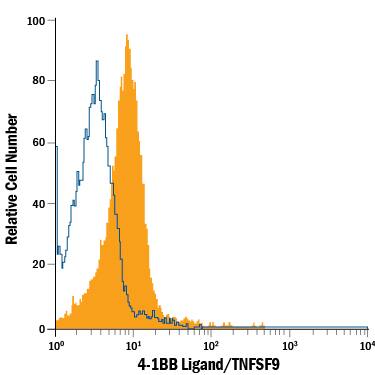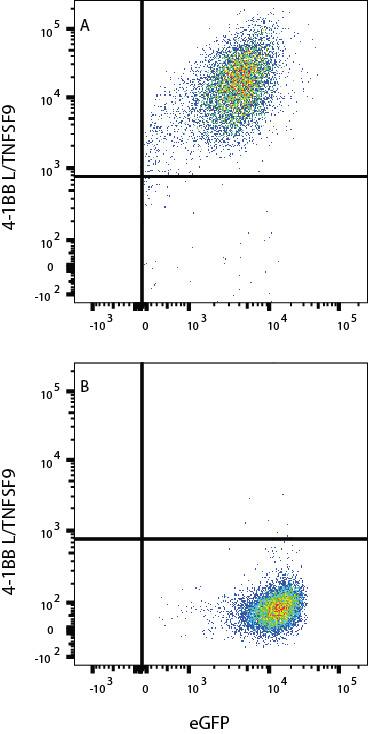Human 4-1BB Ligand/TNFSF9 APC-conjugated Antibody
R&D Systems, part of Bio-Techne | Catalog # FAB2295A


Key Product Details
Species Reactivity
Applications
Label
Antibody Source
Product Specifications
Immunogen
Arg71-Glu254
Accession # P41273.1
Specificity
Clonality
Host
Isotype
Scientific Data Images for Human 4-1BB Ligand/TNFSF9 APC-conjugated Antibody
Detection of 4‑1BB Ligand/TNFSF9 in Daudi Human Cell Line by Flow Cytometry.
Daudi human Burkitt's lymphoma cell line was stained with Mouse Anti-Human 4-1BB Ligand/TNFSF9 APC-conjugated Monoclonal Antibody (Catalog # FAB2295A, filled histogram) or isotype control antibody (IC0041A, open histogram). View our protocol for Staining Membrane-associated Proteins.Detection of 4-1BB Ligand/TNFSF9 in HEK 293 cells transfected with Human 4-1BBL by Flow Cytometry
HEK 293 cells transfected with Human 4-1BBL (A) vs Irrelevant (B) were stained with Mouse Anti-Human 4-1BB Ligand/TNFSF9 APC-conjugated Monoclonal Antibody (Catalog # FAB2295A) and eGFP. View our protocol for Staining Membrane-associated Proteins.Applications for Human 4-1BB Ligand/TNFSF9 APC-conjugated Antibody
Flow Cytometry
Sample: Daudi human Burkitt's lymphoma cell line; Transfectants
Formulation, Preparation, and Storage
Purification
Formulation
Shipping
Stability & Storage
- 12 months from date of receipt, 2 to 8 °C as supplied.
Background: 4-1BB Ligand/TNFSF9
4-1BB Ligand (4-1BBL; also TNFSF9 and CD137L) is a 32 kDa type II transmembrane protein that belongs to the TNF superfamily (TNFSF) molecules (1‑4). The human 4-1BBL cDNA encodes a 254 amino acid (aa) protein that contains a 25 aa N-terminal cytoplasmic domain, a 23 aa transmembrane segment, and a 206 aa C-terminal extracellular region (5). The extracellular domain (ECD) of 4-1BBL has a jelly-roll, beta-sandwich tertiary structure that is similar to other TNFSF members. There is only one cysteine in the human ECD, and no potential N-linked glycosylation sites. The potential exists, however, for O-linked glycosylation. The human 4-1BBL ECD shares 32% and 35% aa identity with mouse and rat ECD, respectively. In the cytoplasmic domain, human 4-1BBL is 55 aa shorter than the equivalent region in rodents. 4-1BBL is expressed by activated B cells, macrophages, dendritic cells, activated T cells, neurons and astrocytes (2, 3, 6). A bioactive 26 kDa soluble form of 4-1BBL, presumably generated by MMP cleavage, occurs in humans (4). Human 4-1BBL signals through both CD137/4-1BB and itself. Its cytoplasmic tail participates in reverse signaling that induces apoptosis in T cells and cytokine secretion (IL-6; TNF-alpha) by monocytes (7, 8). 4-1BBL binding to CD137/4-1BB produces a number of effects. It seems to play a key role in the T cell recall response. It maintains T cell numbers at the end of a primary response, and induces CD4+ and CD8+ T cells to proliferate and secrete cytokines such as IL-2 and IFN-gamma in CD4+ cells, and IFN-gamma in CD8+ cells (9, 10).
References
- Kwon, B. et al. (2003) Exp. Mol. Med. 35:8.
- Salih, H.R. et al. (2002) Int. J. Clin. Pharmacol. Ther. 40:348.
- Vinay, D.S. and B.S. Kwon (1998) Semin. Immunol. 1:481.
- Salih, H.R. et al. (2001) J. Immunol. 167:4059.
- Alderson, M.R. et al. (1994) Eur. J. Immunol. 24:2219.
- Reali, C. et al. (2003) J. Neurosci. Res. 74:67.
- Michel, J. et al. (1999) Immunology 98:42.
- Langstein, J. et al. (1998) J. Immunol. 160:2488.
- Wen, T. et al. (2002) J. Immunol. 168:4897.
- Dawicki, W. and T.H. Watts (2004) Eur. J. Immunol. 34:743.
Alternate Names
Gene Symbol
UniProt
Additional 4-1BB Ligand/TNFSF9 Products
Product Documents for Human 4-1BB Ligand/TNFSF9 APC-conjugated Antibody
Product Specific Notices for Human 4-1BB Ligand/TNFSF9 APC-conjugated Antibody
For research use only
